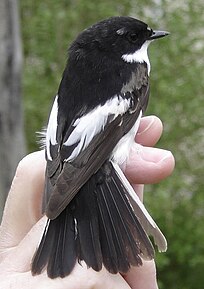European pied flycatcher
| Pied Flycatcher | |
|---|---|

| |
| Adult male | |
| Scientific classification | |
| Kingdom: | |
| Phylum: | |
| Class: | |
| Order: | |
| Family: | |
| Genus: | |
| Species: | F. hypoleuca
|
| Binomial name | |
| Ficedula hypoleuca (Pallas, 1764)
| |
The Pied Flycatcher, Ficedula hypoleuca, is a small passerine bird in the Old World flycatcher family, one of the four species of Western Palearctic black-and-white flycatchers. It breeds in most of Europe and western Asia. It is migratory, wintering mainly in western Africa.
Description
This is a 12-13.5 cm long bird. The breeding male is mainly black above and white below, with a large white wing patch, white tail sides and a small forehead patch. The Iberian subspecies iberiae (known as Iberian Pied Flycatcher) has a larger forehead patch and a pale rump. Non-breeding males, females and juveniles have the black replaced by a pale brown, and may be very difficult to distinguish from other Ficedula flycatchers, particularly the Collared Flycatcher, with which this species hybridizes to a limited extent (Parkin 2003).
The bill is black, and has the broad but pointed shape typical of aerial insectivores. As well as taking insects in flight, this species hunts caterpillars amongst the oak foliage, and will take berries. It is therefore a much earlier spring migrant than the more aerial Spotted Flycatcher, and its loud rhythmic and melodious song is characteristic of oak woods in spring.
They are birds of deciduous woodlands, parks and gardens, with a preference for oak trees. They build an open nest in a tree hole, and will readily adapt to an open-fronted nest box. 4-10 eggs are laid.
The very similar Atlas Flycatcher (Ficedula speculigera), of the mountains of north west Africa was formerly classed as subspecies of the Pied Flycatcher.
Status in England
It has on average decreased in population by 25% within the last 25 years. It has ceased to breed in several parts of its former range within Britain. Records of its location can be found on that National Biodiversity Network here [1].
Lifecycle
- mid-September to mid-April: lives in sub Saharan Africa
- mid April to end of May: migrates and arrives in countries such as the United Kingdom
- June to August: breeding season, one brood only
- August to mid September: flies back to sub Saharan Africa
Management and Conservation
They breed in upland broadleaf woodland. This means that in Britain they are limited due to Geography to the North and West. They prefer mature oak woodland, but also breed in mature upland ash and birch woods.
They require very high horizontal visibility - a low abundance of shrub and understorey, but with high proportion of moss and grass. Grazing needs to be managed to maintain this open character, but also allow the occasional replacement trees.
They will sometmes use mature open conifer woodland where natural tree holes occur. Generally they prefer trees that have tree holes, i.e. dead trees, or dead limbs on healthy trees. They also like lichens that grow on trees.
Nest boxes are not likely to be required.[1]
Grant funding for Conservation
The Forestry Commission offers grants under a scheme called England's Woodland Improvement Grant (EWIG); as does Natural Englands Environmental Stewardship Scheme.
References
- Template:IUCN2006 Database entry includes justification for why this species is of least concern
- Parkin, David T. (2003): Birding and DNA: species for the new millennium. Bird Study 50(3): 223–242. HTML abstract
- ^ RSPB Woodland Management For Birds - Pied Flycatcher
External links
- Ageing and sexing (PDF) by Javier Blasco-Zumeta
- Avibase
- Oiseaux Images.
- RSPB Website Description
- Song of a Pied Flycatcher - a British Library sound recording

